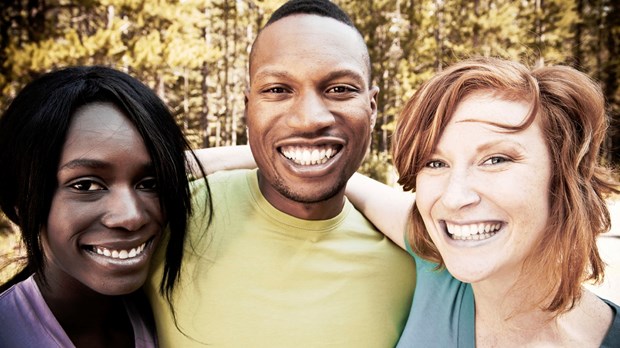Dare to See the "Other"

When my friend Mandy and I are out on our power walk, we’ll smile and nod knowingly when we pass another pair of middle-aged white women out getting their cardio. If a Duke undergrad jogs by, especially one who—sans the jogging—reminds us of our own college days, we’ll offer a nod or a friendly wave to let her know we see her. And if we cross paths with someone either one of us attends church with, we may even pause to chat.
Because we’re super-friendly gals.
But there are others—the men who faithfully empty our trash and recycling every Tuesday, or a newly immigrated Latina mom at the bus stop, or a pale teenager barreling down our street on his noisy skateboard—who can just become the “scenery” for our walk. And if Mandy is describing something fascinating that happened at work, or if I’m complaining about something catastrophic—like letting my $5 grocery coupon expire—we might walk past these “others” without ever noticing them at all.
And I want to ask why.
Seeking Answers
A recent Maclean’s article reports that, today, half of all Americans don’t know the names of our neighbors. I was interested to learn the beginning of this slippery slope toward anonymity didn’t begin with the Internet, video games, and cell phones. (Though, today, they’re not helping.) Actually, it began with the automobile! When folks who used to work near home on farms, or walk to work at the local mill, or catch a bus to the factory began driving to their jobs, we began to disconnect from our neighbors.
And while this research does explain the distance from neighbors with whom we’re no longer sharing intimate physical space—meals, bus rides, playdates—it still doesn’t get at this wily business about which neighbors we see and acknowledge and which ones we don’t. It doesn’t explain how we self-select the neighbors who are worth noticing—at a gas station, or restaurant, or department store—and the ones we silently deem are not.
That—intentionally or unintentionally failing to see the person before us—is the question Christians must answer today. Especially, I’d argue, white ones.
As I’ve listened to some of my black friends over the last several months, they’ve been describing this very experience of invisibility. Too seldom, in their experience, have white folks been willing to look past the color of their skin to know who they really are. This sinister spectrum of un-acknowledgment ranges from the aforementioned “invisibility” (not even noticing or acknowledging someone’s physical presence) to “criminality” (assuming the person in front of you is a sinister someone he may or may not actually be).
The experience of my friend Tyreek is a good example. Regularly, white folks will step in front of him while he’s waiting to place his order at a restaurant or buy a ticket to see a movie. Occasionally, one will remark, “You weren’t in line, were you?” (Yes, actually, he was.) Or a group of white folks walking down the sidewalk—expecting him to evaporate or step out of their way?—will not make room for Tyreek to pass. As if he does not exist. And the heartbreaking flipside of the sidewalk-block is when a woman will cross over to the opposite side of the street when she sees Tyreek walking in her direction. (You’re not fooling anyone, sister, even when you do it a block in advance.) She’ll typically become visibly fearful, grabbing her cell phone or clutching her car keys. She sees his physical body, but she doesn’t see who he is or even who he might be. In her heart and mind, she has, usually unwittingly, masked Tyreek with a costume that disguises who he really is.
The Visibility of Worth
For many Christians, our behavior among those who are “other” than we are—a different subset for every one of us!—is not yet aligned with what we say we believe. The theological answer to the question, “Who is this ‘other’ I’m passing on the street?” is a person who bears God’s holy image (). And the theological answer to the question, “How am I to respond to this ‘other’?” is love your neighbor as you love yourself (). Both are Christianity 101. And yet when we fail to recognize the inherent worth of another, perhaps simply because we’ve not “seen” him, we inevitably fail to behave toward him, to love him, the way we love ourselves.
If we are to love our neighbor, we must first see him, to the degree we’re able, as he really is. So although each of us is laden with assumptions about the people we encounter each day, every one of us can choose to examine the assumptions we’ve chosen and, perhaps more importantly, the ones we haven’t.
One day, when I began to notice a fearful impulse in myself when encountering a black teenager, I thought: Maybe this guy isn’t like the gang-bangers I’ve seen in Hollywood films. Just maybe this young man is like my amazing, bright, sensitive neighbor Frank, a young black man who offered his homecoming king crown, as soon as he was crowned, to a young Indian man with developmental disabilities.
(Wonderfully true story.)
As I passed this young man I didn’t know, you can bet my delighted face was not flushed with fear.
I’ve also toyed with: Maybe he’s like another neighbor, delightful 18-year-old Antonio, a precious son and brother, who’s working two jobs so he can afford college next year.
When I open my imagination to the possibility that someone I don’t yet know might be more than I can imagine, I’m better able to love.
I’m also better equipped to receive and welcome another with a face that is gracious. Have you seen this gracious face? Can you picture it? In my childhood, it was Mister Rogers, on PBS, who communicated, with his entire being, that he was just so glad I’d sit down in front of the TV that day to be his neighbor. Maybe it’s a grandmother who thinks you’re the cat’s meow. Or a friend’s mom who thinks you walk on water. Who is it that has delighted in you? Because that’s the face that communicates to others, even those we pass on the street, “You are worth knowing and loving.” A face that receives others as they are, and not as we imagine them to be, is the natural response to someone you believe to be exceedingly precious and altogether worth receiving, knowing, and loving.
Seeing Your Neighbor
Begin to notice who it is in the natural rhythm of your days you’ve not yet noticed and acknowledged. Maybe it’s Sarah, who works the drive-through window at Burger King. Maybe it’s your bank teller, Noreen. Maybe it’s Jon-Jon, who bags your groceries. Or Anthony, who often waits at the bus stop near your home. Start to notice these precious ones and to communicate—with your face and voice and body—they are worth seeing and worth knowing.
Now when Mandy and I are out walking, she’s learned to pace and pause her stories if we’re passing a cluster of garbage workers or a herd of skateboarders, since she knows I’m not going to not see them. I’ve stopped our conversations enough times to greet unlikely strangers that she knows I’m going to see them and acknowledge them.
I hope you will too.
Margot Starbuck is a writer, speaker, TCW regular contributor, and author of several books, including her most recent, Not Who I Imagined: Surprised by a Loving God (Baker Books). Connect with her on Facebook, Twitter, or at MargotStarbuck.com.
Read more articles that highlight writing by Christian women at ChristianityToday.com/Women
 Read These Next
Read These Next

 Jesus Doesn't Call Us to Merely Be NiceThe life-changing challenge from the Good Samaritan
Jesus Doesn't Call Us to Merely Be NiceThe life-changing challenge from the Good Samaritan

 Waiting for God to SpeakPsalm 28
Waiting for God to SpeakPsalm 28








 Homepage
Homepage
